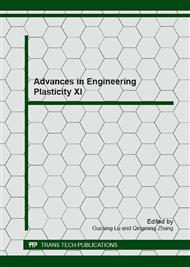p.434
p.441
p.445
p.449
p.453
p.457
p.461
p.465
p.469
Analysis for the Impact of an Engine Hood to a Radiator Support Frame in a Car Body Structure
Abstract:
The dynamic behavior of a radiator support frame impacted by a free-falling engine hood was studied with the use of the 3-D finite element simulations. The engine room including an engine hood, a radiator support frame, and a hood ledge was modeled first. Taking computing efficiency and accuracy into account, approaches for selecting element size, cleaning up complicated features of CAD files were then studied. In order to make the simulations more efficient, the contact spot weld model was adopted. To further reduce the computing time, a theoretical model was also proposed in the present study to calculate the instantaneous angular velocity of the engine hood at the incipient impact to the radiator support frame. The engine hood free-falling tests were also conducted to validate the finite element simulations. The consistency between the experimental data and the simulation results confirms the validity of the finite element model constructed in the present study.
Info:
Periodical:
Pages:
453-456
Citation:
Online since:
January 2013
Authors:
Price:
Сopyright:
© 2013 Trans Tech Publications Ltd. All Rights Reserved
Share:
Citation:


